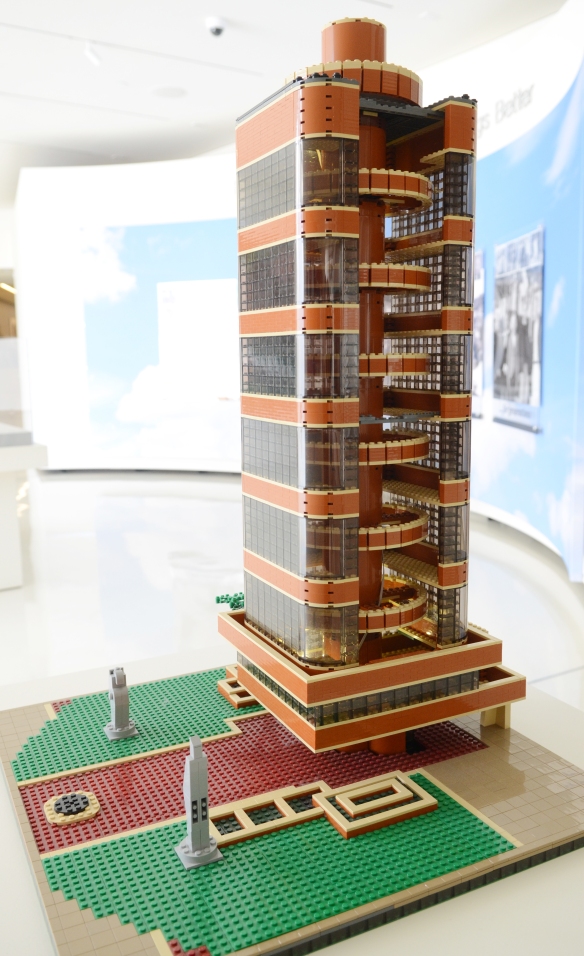(c) Mark Hertzberg If imitation is indeed the sincerest form of flattery (Charles Caleb Colton, 1820), then Frank Lloyd Wright’s SC Johnson Research Tower has many admirers. The latest incarnation of the Tower is a Lego model built by Chris Eyerly of Kenosha. It is displayed in Fortaleza Hall on the company campus.
The first spin-off of the Tower was a desk lighter commissioned by H.F. Johnson Jr. in 1946, the year before construction began, to mark the company’s 50th anniversary. Famed industrial design Brooks Stevens delighted in “literally knocking the great Wright down to size” when he designed the lighter, according to Glenn Adamson, who profiled Stevens in 2003 for an exhibition at the Milwaukee Art Museum.
It was followed sometime after 1960 by a Christmas candle. While the lighters are collectors’ items today, fetching prices up to $700 on sites like eBay, the candle was not as successful, according to the late Serge Logan, who worked in community relations for the company. People liked the “gorgeous smell,” Logan recalled, “I think we got them in Maine somewhere because of the smell of the pines.” But the company that made the candles did not pack them well enough, and many cracked during shipping.
There was also a golden charm of the Tower offered for sale to employees in 1971 for $5. It was made by Tiffany & Company. It was packaged in a blue leatherette jewelry case with the Tiffany trademark.
Eyerly, 39, is an IT security engineer who enjoys challenging himself by designing Lego models. He incorporates his admiration of Wright’s work into his hobby. The Tower is his second Wright Lego creation. Six years ago he used 15,000 of the plastic building bricks to make a four-foot wide model of the Frederick Robie House in Chicago.
He uses practical considerations in deciding what to build, “If certain Lego pieces fit the shape of the building, that’s a key that’s something I can build. The round corners (of the Tower) were just the right shape. Realizing I could accomplish that was the impetus I could build that building.”
SC Johnson gave him PDF copies of some of the original drawings for the building. Eighty hours later, over some two and a half months in the summer of 2012, up to 6,000 Lego blocks in eight colors had been transformed into an almost three-foot tall model of Wright’s landmark Tower.
Eyerly planned one floor of the Tower model in a computer Lego CAD program to help him estimate how many pieces he would need. “I don’t do a ton in CAD. It’s mostly a free build, just snapping pieces together. I do a lot of math ahead of time. That’s why I like scale drawings, so I know how many studs (the round knob atop each brick) it needs to be.”
His models don’t come together easily. He had to rebuild the Robie House four times, the Tower twice. “You get to a certain point and realize something won’t work and you take it apart and retry.”
The company learned about the Tower model after Eyerly showed it at the Brick World Lego convention in Wheeling, Illinois, and invited him to display it at their headquarters. Eyerly enjoys peoples’ reactions to his models because they evoke emotional responses, he says. “Wright’s architecture is interesting. It often draws out memories from people. Often you get emotions or feelings from people. It often ties in personally for people, which makes it interesting for me to hear the stories.” That is even more the case with the Tower model because he knows many people who work at SC Johnson. His next model will be Wright’s Bernard Schwartz House (1939) in Two Rivers, Wisconsin. Ironically, construction was supervised by Edgar Tafel, one of Wright’s original Taliesin Fellowship the apprentices. Tafel had already supervised construction of the SC Johnson Administration Building and Wingspread, as well as part of Fallingwater.










